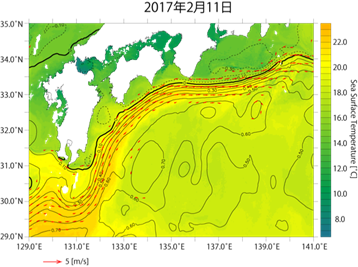Study on development of satellite-based ocean data assimilation system
JAXA Supercomputer System Annual Report April 2016-March 2017
Report Number: R16E0098
- Responsible Representative: Teruyuki Nakajima(Earth Observation Research Center)
- Contact Information: Misako Kachi(kachi.misako@jaxa.jp)
- Members: Misako Kachi, Tsutomu Hihara, Hidenori Aiki, Yasumasa Miyazawa
- Subject Category: Space(Satellite utilization)
Abstract
We will distribute long-term data sets of ocean and sea ice, which are essential to climate change monitoring and prediction, by utilizing satellites. Ocean environmental data sets are also produced by combining satellite, in-situ and model. Those data sets will also contribute to operational applications, such as utilization in sea state monitoring at fishery experiment stations in each prefecture.
Goal
To expand necessity and usage of JAXA’s Earth observation satellites through utilization of ocean and sea ice data sets produced from Earth observation satellites and continuous ocean environmental data sets combining satellite data, in-situ data and ocean model in climate change studies and operational applications.
Objective
To contribute climate study, we will develop and release satellite long-term data sets for ocean and sea ice using various Earth observation satellites including JAXA satellites. In addition, we produce continuous ocean environmental data sets and forecasts combining satellite data, in-situ data and ocean model, which cannot be produced from satellite only, and contribute to operational utilization, such as fisheries.
References and Links
Please refer ‘Ocean Environment Monitoring | Earth Observation Priority Research | JAXA Earth Observation Research Center (EORC)‘.
Use of the Supercomputer
Install and develop the satellite data assimilation system, developed in collaboration with JAMSTEC and based on high-resolution (3km) ocean model over the South of Japan into JSS2 and investigate how to operate the system in JSS2 and apply the system to other ocean area.
Necessity of the Supercomputer
The data assimilation system and model cannot execute in Linux computers generally used at EORC, since the ocean model over the south of Japan is high-resolution (3km), satellite data is assimilated to the system daily, and forecast three-dimensional ocean physical parameters about 80 days in future. Therefore, we need super computer to do this study.
Achievements of the Year
We installed the satellite data assimilation system developed in collaboration with JAMSTEC and based on high-resolution (3km) ocean model over the South of Japan in JSS2. We developed and tested the system that can be operated in JSS2. Fig. 1 is analysis data derived from data assimilation calculated at JSS2. Figure shows sea surface temperature (color), sea surface height (contour), and sea surface current direction and speed (vector) on February 11, 2017, and vectors, which are higher than 0.5m/s, are only shown in the figure. Source codes and data used in analysis are the same as those originally used in JAMSTEC’s Earth Simulator system and we confirmed output results from both systems are the same. Computation time, which strongly depends on node numbers and core numbers, required for satellite data assimilation and model calculation is are 20 minutes (assimilation) and 30 minutes (model) in the Earth Simulator, and 7 minutes (assimilation) and 4 minutes (model) in JSS2, respectively. Therefore, we confirm that computation process is highly improved in JSS2 compared to the Earth Simulator. We also investigate necessary modification and input/output data for future operation in JSS2 and application to the other ocean areas.
Publications
N/A
Computational Information
- Parallelization Methods: Hybrid Parallelization
- Process Parallelization Methods: MPI
- Thread Parallelization Methods: Automatic Parallelization
- Number of Processes: 20,32
- Number of Threads per Process: 32,8
- Number of Nodes Used: 8,20
- Elapsed Time per Case (Hours): 0.0667, 0.1167
- Number of Cases: 15
Resources Used
Total Amount of Virtual Cost(Yen): 17,927
Breakdown List by Resources
| System Name | Amount of Core Time(core x hours) | Virtual Cost(Yen) |
|---|---|---|
| SORA-MA | 4,248.56 | 6,980 |
| SORA-PP | 0.00 | 0 |
| SORA-LM | 0.00 | 0 |
| SORA-TPP | 0.00 | 0 |
| File System Name | Storage assigned(GiB) | Virtual Cost(Yen) |
|---|---|---|
| /home | 33.38 | 50 |
| /data | 333.79 | 507 |
| /ltmp | 6,835.94 | 10,389 |
| Archiving System Name | Storage used(TiB) | Virtual Cost(Yen) |
|---|---|---|
| J-SPACE | 0.00 | 0 |
Note: Virtual Cost=amount of cost, using the unit price list of JAXA Facility Utilization program(2016)
JAXA Supercomputer System Annual Report April 2016-March 2017



